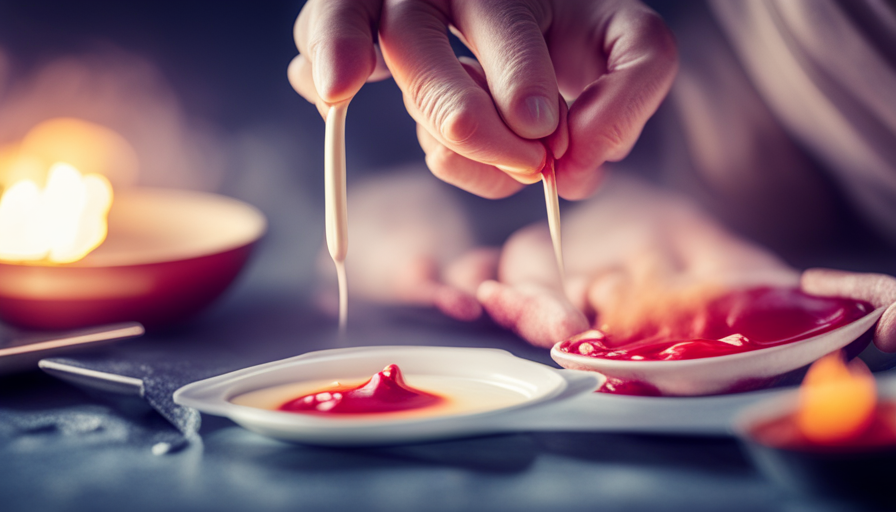Are you ready to embark on a journey into the world of delightful fragrances? Imagine the gentle glow of candles casting a warm light in your home, combined with the rich, alluring aroma of your favorite scent. Now is the time to explore the process of making candle melts, those small scent capsules that will transform your home into a peaceful sanctuary.
In this article, I will guide you through the process, step by step, so you can create your very own homemade candle melts. We’ll gather our supplies, choose the perfect wax, and select a fragrance that will transport you to your happy place. With just a few simple steps, you’ll have beautifully scented melts to enjoy or gift to loved ones.
So, roll up your sleeves and get ready to unleash your creativity. Making candle melts is a delightful and rewarding experience, allowing you to personalize your space with scents that speak to your soul.
Let’s dive in and create some magic together!
Key Takeaways
- Candle melts can be made using various types of wax such as soy wax, beeswax, paraffin wax, or coconut wax.
- Soy wax is a popular choice for candle melts due to its eco-friendly nature and clean burn.
- Fragrance options for candle melts include essential oils, fragrance oils, or blends, with popular choices being lavender, citrus, vanilla, fresh linen, or caramel.
- To make candle melts, the steps involve melting the wax, adding the fragrance, and pouring the mixture into molds.
Gather Your Supplies
Now, it’s time to gather all your supplies and get ready to dive into the world of candle melts – you’re in for a delightful and enchanting experience!
To begin, you’ll need a few essential items. First, choose your wax. There are different types of wax available for making candle melts, each with its own unique qualities. Soy wax is a popular choice, known for its clean burn and excellent scent throw. Beeswax is another great option, as it produces a warm, natural glow and has a subtle honey fragrance. Paraffin wax is widely used and offers a strong scent throw, making it perfect for creating highly fragrant melts.
Next, consider the fragrance. When choosing the right fragrance for your candle melts, it’s important to think about the mood or atmosphere you want to create. Floral scents like lavender or jasmine can promote relaxation, while fruity scents like citrus or berries can add a refreshing touch. Additionally, you can experiment with different combinations to create unique and personalized fragrances.
Now that you’ve gathered your supplies, let’s move on to choosing the perfect wax for your candle melts.
Choose Your Wax
First, you’ll want to decide which type of wax suits your preferences best, such as soy wax, which is known for its clean and long-lasting burn. Imagine how delightful it would be to fill every corner of your home with the warm and inviting fragrance of lavender-scented soy wax melts.
When it comes to making candle melts, there are different types of wax to choose from. Here are some options to consider:
-
Soy wax: Derived from soybean oil, soy wax is a popular choice among candle makers. It has a lower melting point, allowing for a longer burn time and a cleaner, soot-free experience.
-
Beeswax: Known for its natural golden color and sweet, honey-like scent, beeswax is another excellent option. It releases negative ions, which can help purify the air in your home.
-
Paraffin wax: This traditional wax is widely available and budget-friendly. It offers a strong scent throw and a smooth texture, making it a favorite among many candle enthusiasts.
-
Coconut wax: Made from coconut oil, this wax has a creamy texture and excellent fragrance retention. It burns slowly and evenly, providing a long-lasting aroma.
Using soy wax for candle melts has several benefits. It’s a renewable resource, making it an eco-friendly option. Soy wax also produces less soot and releases fragrance more effectively compared to other waxes.
Now that you’ve chosen your wax, it’s time to move on to the next step and select your fragrance.
Select Your Fragrance
Once you’ve chosen your wax, it’s time for you to indulge in the delightful task of selecting your preferred fragrance. The fragrance you choose for your candle melts is what will make them truly special and unique. There are different types of candle fragrances available, including essential oils, fragrance oils, and blends. Essential oils are derived from plants and offer natural scents like lavender, citrus, and eucalyptus. Fragrance oils, on the other hand, are synthetic and offer a wider variety of scents, such as vanilla, caramel, and fresh linen. Blends combine both essential and fragrance oils to create unique combinations.
To help you choose the perfect fragrance for your candle melts, here is a handy table that showcases some popular scents and their characteristics:
| Fragrance | Description |
|---|---|
| Lavender | Calming and relaxing, perfect for creating a soothing atmosphere |
| Citrus | Energizing and refreshing, great for boosting mood and productivity |
| Vanilla | Warm and comforting, creates a cozy and inviting ambiance |
| Fresh Linen | Clean and crisp, reminiscent of freshly laundered clothes |
| Caramel | Sweet and indulgent, adds a touch of decadence to any space |
Once you’ve selected your fragrance, it’s time to move on to the next step – melting the wax.
Melt the Wax
To begin the process, you’ll need to melt the wax, allowing it to transform into a luxurious, liquid state. This step is crucial in creating the perfect candle melts.
Here are some tips for achieving the perfect melt consistency:
-
Choose the right wax: There are different types of wax you can use for candle melts, such as soy wax, beeswax, or paraffin wax. Each type has its own melting point and characteristics, so choose the one that suits your needs best.
-
Use a double boiler: Place the wax in a heat-safe container and set it over a pot of simmering water. The indirect heat from the steam will gently melt the wax without causing it to burn or overheat.
-
Stir occasionally: As the wax melts, stir it gently to ensure even heating and prevent any clumps or uneven consistency.
-
Monitor the temperature: It’s important to keep an eye on the temperature of the wax. Different waxes have different melting points, so make sure to melt it at the recommended temperature to achieve the desired consistency.
By following these tips, you’ll be able to melt the wax to the perfect consistency for your candle melts.
Now, it’s time to move on to the next step and add the fragrance.
Add the Fragrance
Now comes the fun part – infusing your wax with a delightful fragrance that will transport you to a world of relaxation and serenity. Adding fragrance to your candle melts is what elevates them from ordinary to extraordinary. There are different types of candle fragrances available, each offering a unique scent profile that can enhance the ambiance of any space. When choosing the right fragrance for your candle melts, consider the mood you want to create and the preferences of your intended audience.
To help you make an informed decision, here is a table outlining three popular types of candle fragrances:
| Fragrance Type | Scent Profile | Best Use |
|---|---|---|
| Floral | Light, fresh, and feminine scents | Perfect for creating a calming and romantic atmosphere |
| Woody | Earthy, warm, and musky scents | Ideal for cozy evenings or creating a rustic ambiance |
| Citrus | Refreshing, uplifting, and fruity scents | Great for energizing spaces or creating a cheerful environment |
By carefully selecting the fragrance that aligns with your desired atmosphere, you can create a truly immersive experience for yourself and others. Now that your wax is infused with the perfect scent, it’s time to pour it into molds and shape your candle melts.
Pour the Wax into Molds
Gently pour the scented wax into your chosen molds, shaping them into beautiful and unique forms. When it comes to candle melts, the possibilities are endless.
There are various types of molds available in the market, ranging from classic shapes like hearts and stars to more intricate designs like flowers and animals. You can even use silicone molds that come in different sizes and patterns. Experimenting with different molds allows you to create melts that suit your personal style and preferences.
To achieve the perfect melt consistency, it’s important to follow a few tips. Firstly, make sure the wax is heated to the recommended temperature. This will ensure that it pours smoothly into the molds without any lumps or clumps. Secondly, avoid overfilling the molds as it can lead to uneven melting and difficulty in removal. Fill them up to three-quarters full to allow room for expansion and easy release. Lastly, gently tap the molds on a flat surface to remove any air bubbles that may have formed during the pouring process.
Once you have poured the wax into the molds, it’s time to let the melts harden. This step is crucial as it allows the wax to solidify and take the desired shape.
Let the Melts Harden
Once you’ve poured the wax into the molds, sit back and watch as your beautiful creations transform into solid masterpieces. It’s important to let the melts harden completely before moving on to the next step. This will ensure that they maintain their shape and don’t break when you try to remove them from the molds. Depending on the type of wax you’re using, this process can take anywhere from a few hours to overnight.
While you wait for the melts to harden, you can start thinking about how you want to decorate them. There are so many creative options to choose from! You can add dried flowers, herbs, or even glitter to make your melts stand out. Just make sure that anything you add is heat-safe and won’t catch fire when the melts are lit.
Once the melts have hardened and you’ve decorated them to your liking, it’s time to package and gift them. You can use small plastic bags or boxes to keep them protected and looking presentable. Consider adding a personalized label or tag to make them even more special. Candle melts make great gifts for birthdays, holidays, or just as a thoughtful gesture.
Now that your melts are beautifully decorated and packaged, it’s time to move on to the next step: popping them out of the molds.
Pop out the Melts
When you’re ready, you can easily release your beautiful creations from the molds and unveil their stunning designs.
Removing the melts from the molds is a crucial step in the process, and with a few simple tips, it can be done effortlessly.
Firstly, ensure that the melts have completely hardened before attempting to pop them out. This will prevent any mishaps and ensure that the melts maintain their shape.
Gently tap the bottom of the mold to loosen the melts, and then carefully push them out from the bottom. If you’re having trouble, you can try placing the mold in the freezer for a few minutes to help loosen the melts.
Additionally, using silicone molds can make the removal process even easier, as the flexibility of the material allows for smooth release.
With these tips, you’ll be able to remove your melts without any hassle and enjoy the fruits of your labor.
Now, let’s move on to the next step where we’ll discuss how to store your melts without compromising their quality.
Store Your Melts
After popping out the melts from their molds, it’s time to move on to the next step: storing your homemade candle melts.
Proper storage is crucial to ensure that your melts maintain their fragrance and shape until they’re ready to be used. There are a few different ways you can store your melts, depending on personal preference and the space you have available.
One option is to place them in airtight containers or ziplock bags. This’ll help to preserve their scent and prevent any dust or debris from settling on them. Another option is to use small glass jars or containers with lids. This not only keeps your melts fresh but also allows you to showcase them in an aesthetically pleasing way. You can arrange them in a decorative tray or on a shelf, creating a stunning display that adds a touch of ambiance to any room.
When it comes to storing your melts, it’s important to keep them away from direct sunlight and extreme temperatures. Heat can cause them to melt prematurely, while sunlight can fade their colors and weaken their fragrance. Find a cool, dark place to store them, such as a cupboard or drawer.
Now that your melts are safely stored, let’s move on to the next section where we’ll discuss how to enjoy your homemade candle melts without writing ‘step’.
Enjoy Your Homemade Candle Melts
To fully appreciate the delightful aroma and ambiance of your homemade melts, simply place them in a wax warmer and let the soothing fragrance fill the room. Homemade candle melts offer a wide range of fragrances that you can experiment with to create your desired atmosphere.
From calming lavender to invigorating citrus, the options are endless. You can even combine different scents to create unique blends that suit your preferences.
When it comes to packaging and gifting your homemade melts, there are several options to consider. One option is to place them in small, decorative containers or tins. You can add a personalized touch by attaching a handwritten label with the scent name and any special instructions.
Another option is to package them in small organza bags, tied with a ribbon or twine. This not only adds an elegant touch but also makes it easy to distribute and share your melts with others.
Homemade candle melts make wonderful gifts for birthdays, holidays, or any special occasion. You can create gift sets by combining different scents or packaging them with other homemade bath and body products. Additionally, you can include a small card with instructions on how to use the melts, adding a thoughtful touch to your gift.
Whether you choose to keep them for yourself or share them with others, homemade candle melts are a delightful and personalized way to enjoy the soothing scents of your choice.
Frequently Asked Questions
How long does it take for the candle melts to harden and set?
It typically takes around 2-3 hours for candle melts to harden and set completely. However, there are a few factors that can affect this process. One way to speed up the hardening process is by placing them in the refrigerator for about 30 minutes.
Additionally, if the candle melts aren’t setting properly, it could be due to using too much fragrance oil or not using enough wax. It’s important to follow the instructions and measurements carefully to ensure proper setting.
Can I use other types of fragrance oils instead of specifically designed candle fragrance oils?
Using essential oils in candle melts is a popular alternative to using specifically designed candle fragrance oils. Many people believe that using natural fragrance oils adds a unique and therapeutic element to their candles. Essential oils not only provide a pleasant aroma but also offer potential health benefits. For example, lavender essential oil is known to promote relaxation and reduce stress.
However, it’s important to research and choose essential oils that are safe to use in candle making to ensure a quality product.
What are some common mistakes to avoid when making candle melts?
When it comes to making candle melts, there are a few common mistakes that beginners should avoid.
One of the most important tips is to ensure that you measure the fragrance oil accurately. Using too much or too little can affect the scent throw of your melts.
Another mistake to avoid is not properly mixing the fragrance oil with the wax, which can result in an inconsistent scent.
Lastly, make sure to pour the wax at the right temperature to prevent frosting or cracking.
How do I clean the wax residue from the melting pot or utensils?
To clean wax residue from your melting pot or utensils, start by allowing them to cool completely. Then, use a plastic scraper or spatula to gently remove any excess wax.
Next, fill a sink or container with hot, soapy water and soak the tools for a few minutes. Scrub them with a sponge or brush to remove any remaining wax. For stubborn residue, you can use a wax remover or rubbing alcohol.
Rinse the tools thoroughly and dry them before using again.
Can I mix different fragrances to create unique scents for my candle melts?
Yes, you can definitely mix different fragrances to create unique scents for your candle melts. By combining different scented oils or wax melts, you can create a whole new aroma that’s personalized to your liking.
Experiment with different combinations and ratios to find the perfect blend. Start with a few drops of each fragrance and adjust according to your preference. Mixing fragrances allows you to unleash your creativity and create one-of-a-kind scents for your candle melts.
Conclusion
In conclusion, making candle melts is a delightful and rewarding experience. As I watched the wax transform into a liquid pool, I couldn’t help but feel a sense of transformation in myself.
The fragrance that filled the air symbolized the sweet aroma of accomplishment. With each step, from selecting the perfect wax to popping out the melts, I felt a sense of pride in my creation.
Now, as I store my homemade melts, I know that I have created something truly special. So go ahead, gather your supplies and embark on this wonderful journey of candle making. Enjoy the process and savor the symbolism behind each melt you create.









